It's that time of year, to look back and see what objectives were planned and how effective was I at accomplishing them.
First, I had no plans to start flying again this year. Life was/is still much too hectic for me to engage in another (very expensive time consuming) hobby. So any progress in this area has to be considered a positive. Once I decided to get involved, I had just three objectives: 1) Pass my medical. 2) Pass my Biannual Flight Review for Private Pilot. 3) Fly at least once a week. I planned to start on Instrument Proficiency next year (first half) and perhaps CFI after that.
So, results:
1) I scheduled and passed my 3rd class medical in March. The only restriction is I must wear glasses when I fly.
2) I researched the local area for flight schools. Assessed what I wanted to get out of the training, interviewed some instructors in March and April. I took my first flight in mid-April. I passed the BFR and soloed by the end of May. (Got checked out in a Tiger, then a Warrior, and finally the 'high wing wonder'.)
3) I started flying with 37 weeks left in 2005, I finished the year last night with just over 38 hours. Unfortunately it wasn't every week, but the intent was there.
In addition, I've worked hard on my instrument skills and am getting close to completing the IPC. CFI is still something to consider for next year. (Tailwheel endorsement, Complex a/c)
I underestimated the amount of study required. Books include: Rod Machado's Private Pilot Handbook and Instrument Survival Guide, FAR-AIM, Hayes's Instrument Oral Exam Guide, Eckalbar's IFR: Structured Approach. Various magazines, and of course web sites were all used to get back up to speed. (BTW, I didn't know what a Blog was last year. Podcast?) I also use Microsoft Flight Simulator and the Garmin 430 Simulator.
I also underestimated the 'flight bag'. Headsets (need one for a passenger too), charts, plates, and gadgets like GPS and Transceiver (not needed but definitely nice to have), and other assorted pieces of gear.
So, what about the cost? Roughly twice what I estimated (but then I got further along then initially planned). As my wife said last night "Not a bad investment."
Friday, December 23, 2005
Thursday, December 22, 2005
My Christmas Present
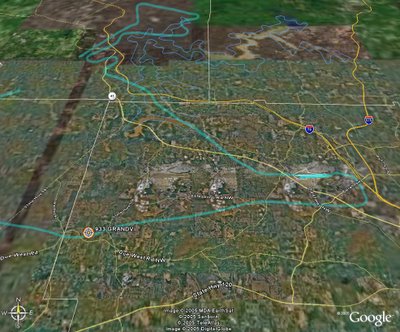
The objectives of this flight: Enjoy.
After all this time, I finally had a chance to fly with Mandy. The weather was great, a bit hazy but ATIS was calling it 10 miles. No clouds and only light winds from the west.
We started the preflight at about 4:30. I carefully explained each step of the procedure, pointing out what I was looking for and why it was important. Same thing once we sat in the cockpit. Gave it some time to sink in, allowed her to ask some questions, and tried to prepare her for what to expect. No surprises. Start, taxi and run up were all normal. Take off was as well, except for her gasps of excitement!
Very smooth air. Climbed to 4500 to get above the haze layer, trimmed it up and let he have the controls. Slow easy turns made easy by the sharp horizontal line caused by the haze. Talked just a little about lift, and why back pressure was needed in a turn. Then I gave some headings to fly, which she did quite well. No problems with airsickness, sinus problems or other distractions. So we flew south for a bit, to enter the pattern from the southwest, hopefully flying over our house. Pretty close, and we did identify our development, but not the house.
The haze mixed with the low light from the setting sun made very poor visibility. Tower was calling traffic within 3 miles that I couldn't see until behind my wing. Navigation lights and beacons just seemed to be a part of the traffic lights below. Entered left traffic number 2 behind a Piper on a right downwind. I was able to pick him up after a few tower calls, and extended the pattern just bit to follow him in.
Checklist complete, on speed, on altitude and the air is smooth as silk. Over the Mall on final, the Piper cleared the runway and it was my turn. Good landing.
"When can we do this again? I mean really?"
Does it get any better then that?
We traveled just 75.4 miles, climbed up to 4627 feet and reached the awesome speed of 135 MPH. What a beautiful night.
C172P
Time = 1.2
Wednesday, December 21, 2005
IFR 10 - IPC (almost)

The objectives of this flight: The Instrument Proficiency Check. I planned the same route as last time, up to Rome, over to Cartersville, and back home. Weather looked good (a little gusty out of the NW, but not bad). Sky as clear as it gets.
However, it was a bit cold, so I got some hands on training on how to use the engine heater. The briefing and preflight were normal. Engine started well (no prime required). Taxi and run up without any problems. Took off to the west and put on the foggles, climbed to 4500.

Radio setup went well. RMG VOR in Nav2, RMG ILS in Nav1, GPS backing up our track to Rome. AMICEATM went fine. We discussed holding entry, and noted on my last flight I entered direct and typically this is a parallel entry. (I pointed out that my heading was 'all over the place due to poor airmanship setting up the GPS, so a direct entry was correct at the time.) Station passage, outbound to the entry, just waiting for the ILS to center. Did not happen, so I used the GPS (which recommended a direct entry) to establish myself outbound. Ahah, ILS still in standby, push the switch and all is ok. (Identify means to actually listen to the dit dah!) ouch

The rest of the approach was fine, down to mins, and could have made the landing. Missed back to the VOR. Nice to have RMG in Nav2 so that I can set up for Cartersville with the GPS. I had selected the Loc like before, but decided to do the VOR A /GPS. This would give me the 'circle to land' approach needed. (Besides I had blown this on IFR 2, so wanted to do it right.) It is an interesting step down approach that takes you right by the cooling towers (1720 ft) at Cartersville. The CFI let me take a peak to underscore the reason for the altitude restrictions. The last step is pretty steep (2200 to 1560 in 1.6 miles). I got to mins, took the foggles off and did a nice circle to land on Rwy 1 (smooth landing).
Cleaned up, climbed out and headed back home. Unfortunately the transponder acted up and we were unable to get vectors for the ILS. We stayed VFR and the CFI provided the vectors needed. More then normal s-corrections, bobbing on GS was not pretty, but not pegged either. (I almost went missed at the Loc mins again.) It was an OK landing.
So, improvement over the last few flights. Airwork is ok, headwork improving. One more flight into a 'strange airport', an "unplanned approach" and maybe some more partial panel work should convince us both that I am ready.
This was a good flight, it should have been great. I know what to do, how to do it, and know when things aren't right, but I'm still not executing to the best of my ability. I'm really looking forward to the next flight.
Focus on the journey, not the destination.
C172p
Time = 1.5
Monday, December 12, 2005
IFR 9 - More Practice

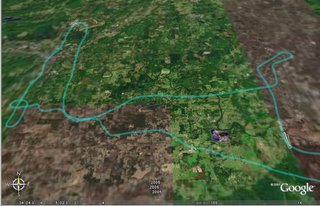
 The objectives of this flight: 1)Build Confidence, 2) Practice procedures.
The objectives of this flight: 1)Build Confidence, 2) Practice procedures.I linked up with a safety pilot for this flight, another private pilot working on his Instrument rating. His job is to look outside for traffic while I wear the foggles and look inside at the instruments.
My plan was to fly VFR direct to the Rome VOR, do the the ILS into Russel (RMG), then right over to Cartersville for the Localizer, then back home and ask for vectors to the ILS at Cobb County.
KRMG 121853Z AUTO 29013G21KT 10SM CLR 13/M01 A2990
KRYY 121845Z 29015G21KT 10SM FEW030 12/M01 A2988
The weather was finally good, although gusting winds to 21 knots would make it interesting. I didn't file a flight plan as most of the work would be around non-controlled fields. The brief, preflight and taxi all went well. It is a little different being in the plane without an instructor, more personal responsibility, less effort to impress. I just felt more comfortable. The safety pilot pointed out things he does a bit different, I shared my procedures, and overall it was a very good 'give and take'. Low voltage light during run-up, avionics off (GPS flight plan lost), master reset, voltage OK.
After we cleared Cobb County airspace I put the foggles on and set up to track inbound to the VOR. Along the way I set up the radios, listened for weather, listened to and advised Rome traffic and generally completed all of AMICEATM. I used the GPS as backup and rediscovered my tendency to apply yoke pressure when fiddling with the GPS. I'm just going to have to put my left hand in my lap when I tune that thing. Otherwise my air work was acceptable, though far from my best.
The ILS uses a holding pattern for the procedure turn, the IAF is defined by the inbound course on the Localizer(Nav 1) and a radial from the RMG VOR (Nav 2). My radio setup was good, and it was nice to have GPS setup as backup and situational awareness. (BTW, approach plates are much easier to read in the daytime.) Gusty winds pushed me around a bit, but I felt very comfortable with the approach. Went to mins and executed the missed back to the VOR.
Since I was tracking with Nav 2, it gave me the opportunity to set up Nav 1 for the next approach. Again, I backed this up with the GPS (careful to scan and not push while tuning in the new procedure). Cartersville had touch and go traffic on the opposing runway, so we stayed at altitude for this one. (Again, I was really interested in procedures, so going down to mins wasn't essential.) Normal procedural turn, intercepted the Loc inbound without any problems, took the foggles off so two sets of eyeballs could look out for traffic. Went missed and told the boys in the pattern I would get out of their way.
Heading east, the setting sun shining on Atlanta was beautiful. City lights were coming on and the traffic jams coming north made me delighted to be in the sky. I contacted approach to see if they could fit me in for vectors to the ILS back home. It must have been a slow night since he gave me a squawk, told me to stay VFR and gave me the vectors I requested. Foggles back on, checklists complete for a beautiful ILS. Foggles off a little above mins, I saw I had maybe 20 degrees crab into the wind so decided to use just 10 degrees of flaps and fly it a little fast. Landing was not my best, but respectable.
Fun! This was a fun flight. I did all of the things I needed to do, found some inherent weakness in my personal routine that can be corrected, and made a new friend at the same time. We traveled 155 miles, got up to 155 mph and climbed all the way up to 3907 feet. (Scattered clouds at 4500 kept us down around 3000 for most of the flight.)

C172p
Time = 1.7
Thursday, December 01, 2005
IFR 8 - Practice, Practice, ...
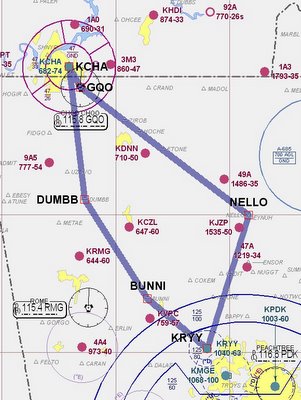
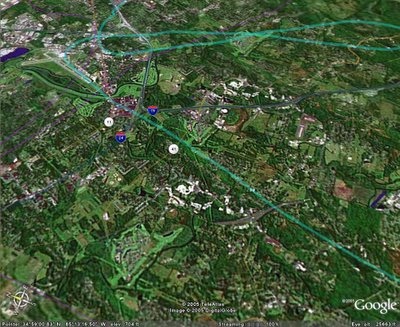
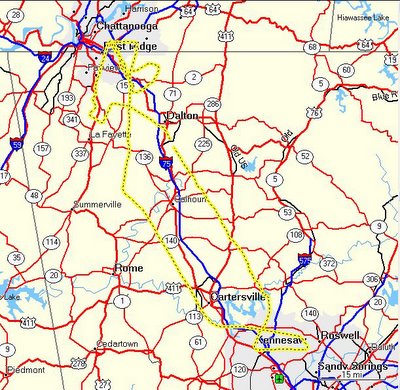 The objectives of this flight: Practice. I filed a flight plan to Chattanooga via airways. I planned to do an ILS followed by VOR/DME arc then back home via standard arrival and a GPS.
The objectives of this flight: Practice. I filed a flight plan to Chattanooga via airways. I planned to do an ILS followed by VOR/DME arc then back home via standard arrival and a GPS.The planning, preflight and takeoff were all normal. We were cleared as filed, which took us to Nello Intersection then V5 into CQO (Choo Choo) for the approaches at KCHA. Two weeks since the last flight, I was a little rusty, or at least not as sharp as I would like. I had to work to track the course, maintain altitude and make the radio calls. The course deviation never got close to pegged, but it was seldom in the donut either.
CHA was pretty busy and I had vectors for spacing before getting on the approach. I was slow to flip the LOC frequency from standby to active and had a difficult time reading the minimums for the approach. (I discovered something here. I've been using a red LED flashlight for my night flying. For whatever reason, when I use that I can't quite focus on the approach plates. Using a standard red flashlight works better for me.) Good course and glideslope, but I missed at the Localizer mins instead of the ILS. (Dummy)
OK, so executed the missed approach and went for the VOR arc. Osily (IAF) is 7 miles out on the 090 radial, and you arc to the south for a 332 final approach course. Winds were quite strong out of the west, so I used a 20 degree cut instead of the normal 10. It worked well. Course control on final was good. Missed there and turned for home.
The air was much smoother on the way home. Basic air work was much better. I asked for and was given the Bunni Two Standard Arrival (STAR), which took us right by RYY. The GPS 27 was good with a nice landing.
Overall it was an OK flight. I was not happy with my air work. It was a good training flight. Nice to go somewhere different, and a great opportunity to review cross country procedures. A little more practice and I should be ready for the IPC.
251 miles round trip, 5047 feet (always just a bit off), and with the tailwind on the way home we got up to 172 mph.
Cessna 172p
Time = 2.6
Subscribe to:
Posts (Atom)